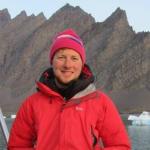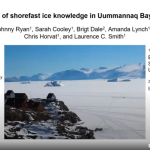Co-production of shorefast ice knowledge in Uummannaq Bay, Greenland
Shorefast ice (also known as landfast ice) is sea-ice that is attached to the coastline. Since it does not drift with the winds and currents, shorefast ice forms an important habitat for wildlife and a platform for human subsistence food production and transport in the Arctic. As the climate warms, residents local to the Arctic report that it is breaking up earlier in the year and is thinner than it was a few decades ago. These environmental changes threaten the sustainability of wildlife and traditional human activities that depend on shorefast ice. Despite its significance, a comprehensive multidisciplinary assessment of shorefast ice has yet to be made in Greenland. This project therefore seeks to understand how shorefast ice has responded to atmospheric and oceanic warming, and how these changes have affected livelihoods in communities local to the Uummannaq region of West Greenland. The results will improve institutional knowledge of environmental change in the Arctic and prediction of its associated impacts, as well as strengthen US relations in an area of, potentially global, strategic and economic importance.
The project will co-produce shorefast ice knowledge by leveraging large satellite remote sensing datasets, community-based monitoring and local and Indigenous knowledge. First, observations from high-resolution optical satellite sensors will be supplemented with knowledge gathered from local residents. A community-based monitoring program will then be initiated using small multi-rotor UAVs to document key shorefast ice processes (e.g. formation and break-up) as they happen. The quantitative and qualitative shorefast ice knowledge generated by these two activities will be used to understand not only how the shorefast ice has changed but how these changes matter to individuals and communities in the Uummannaq region. The involvement of residents and institutions in Uummannaq at all stages of the project, in combination with ongoing observations, will lay the foundations for ongoing community support and enable new insights into the complex social, cultural and economic changes caused by rapid environmental change. The findings will also enhance the ability of local residents and institutions to make informed and embedded choices concerning natural resource governance and management, as well as choices about individual and collective trajectories towards a desirable and sustainable future.
Resources
Co-production of Shorefast Ice Knowledge in Uummannaq Bay, Greenland
A Navigating the New Arctic (NNA) project update video produced for the April 2020 virtual NNA Investigators meeting. The video is narrated by Johnny Ryan (Brown University).
Publications
Project Outcomes
Coastal ice (also known as shorefast or landfast ice) is sea ice that is attached to the coastline. Since it does not drift with the winds and currents, coastal ice forms an important habitat for wildlife and a platform for human subsistence food production and transport in the Arctic. As the climate warms, residents local to the Arctic report that it is breaking up earlier in the year and is thinner than it was a few decades ago. These environmental changes threaten the sustainability of wildlife and traditional human activities that depend on coastal ice. Despite its significance, a comprehensive assessment of coastal ice has yet to be made in Greenland. This project sought to understand how coastal ice has responded to atmospheric and oceanic warming, and how these changes have affected livelihoods in communities local to the Uummannaq region of West Greenland.
We found that coastal sea ice breakup timing is strongly correlated with springtime air temperature and that the sensitivity of the relationship varies substantially among communities. When combined with future warming scenarios, we estimate an annual reduction of 5 - 44 days in the length of the springtime coastal ice season by 2100. While all communities are likely to experience earlier coastal ice breakup in the future, breakup in colder communities is notably more sensitive to changes in springtime air temperature than in warmer communities. This regional variability in breakup sensitivity has contrasting implications for communities in northern Canada and western Greenland, particularly when socioeconomic and cultural differences are also considered. Our results emphasize the local nature of climate change and its varied impacts on Arctic communities.
Due to earlier coastal ice breakup, we found that snowmobile travel in Uummannaq Fjord has become both longer and more unpredictable in recent years, particularly in May. When sea ice is present, travel has been predominantly impeded by a reduced snow cover (since snowmobile is much faster across fresh snow) rather than the opening of fractures. Communities further from Uummannaq (e.g. Niaqornat and Ukkusissat) have experienced greater changes in sea ice travel distance and duration than proximal communities (e.g. Ikerasak). Even over our relatively short study period (1985 to 2019), we find that climate change has hindered sea ice travel and access between communities during spring. This raises concern about the continued inhabitance of remote communities, which are becoming increasingly disconnected from other communities in Spring.
We tested multiple methods for engaging local communities and found that some were more productive than others. For example, the sharing circles method worked particularly well, effectively initiating generational knowledge transfer between youth and elders. We also found that involving youth in producing a video tutorial about measuring sea ice thickness in Greenlandic contributed to citizen science activities while providing a sense of giving back to the community. On the contrary, the kaffemik did attracted visitors and non-locals instead of the intended audience. This stresses the importance of social relations and reason for occasion when organizing such activities. The effect of being present in a community for long periods meant that both planned, and ad hoc conversations informed our work. We also unsurprisingly found that the inclusion of Greenlandic-speaking researchers, especially those with local connections, and practices of knowledge-sharing respectful of local tradition (such as the sharing circle and the conversation in a focus group) greatly improved conversations and knowledge co-production.
The involvement of residents and institutions in Uummannaq at all stages of our project, in combination with ongoing observations, lay the foundations for ongoing community support and enable new insights into the complex social, cultural, and economic changes caused by rapid environmental change. Our findings also enhance the ability of local residents and institutions to make informed and embedded choices concerning natural resource governance and management, as well as choices about individual and collective trajectories towards a desirable and sustainable future.




